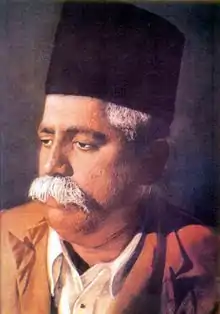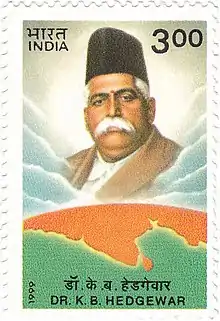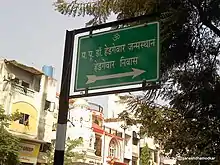K. B. Hedgewar
Keshav Baliram Hedgewar (1 April 1889 – 21 June 1940) was the founding Sarsanghachalak (or "Chief"[1]) of the Rashtriya Swayamsevak Sangh (RSS).[2] Hedgewar founded the RSS in Nagpur in 1925, based on the ideology of Hindutva with the intention of creating a Hindu Rashtra. [3][4]
Keshav Baliram Hedgewar | |
|---|---|
 | |
| Sarsanghchalak of the Rashtriya Swayamsevak Sangh | |
| In office 1925–1940 | |
| Succeeded by | M. S. Golwalkar |
| Personal details | |
| Born | Keshav Baliram Hedgewar 1 April 1889 Nagpur, British India (present-day Maharashtra, India) |
| Died | 21 June 1940 (aged 51) Nagpur, Central Provinces and Berar, British India (present-day Maharashtra, India) |
| Education | Medical College and Hospital, Kolkata |
| Occupation | Physician, Political activist |
| Known for | Founder of Rashtriya Swayamsevak Sangh |
Early life
Hedgewar was born on 1 April 1889 in a Telugu[5][6][7][8] Deshastha Rigvedi Brahmin family in Nagpur.[9][10][11][12][13] His parents were Baliram Pant Hedgewar and Revatibai, a couple of modest means. When Hedgewar was thirteen both of his parents died in the epidemic of plague[14] of 1902. Hedgewar's uncle ensured that he continued to receive a good education, and B.S. Moonje became a patron and a father-figure for the young Hedgewar.
He studied at Neel City High School in Nagpur, from where he was expelled singing "Vande Mataram" in violation of the circular issued by the then British colonial government.[15] As a result, he had to pursue his high school studies at the Rashtriya Vidyalaya in Yavatmal and later in Pune. After matriculating, he was sent to Kolkata by B. S. Moonje (a member of the Congress, who later became the President of the Hindu Mahasabha) in 1910 to pursue his medical studies.[16] After passing the L.M.S. Examination from the National Medical College in June 1916, he completed a yearlong apprenticeship and returned to Nagpur in 1917 as a physician.[17]
Ideological roots
After completing his education, Hedgewar joined the Anushilan Samiti in Bengal, which was influenced deeply by the writings of Bankim Chandra Chatterjee. Hedgewar's initiation into this group, rooted in Hindu symbolism, was an important step in his path towards creating the RSS. Hedgewar was also deeply influenced by Veer Savarkar's treatise Hindutva.[18] Dr. Hedgewar was also highly influenced by Samarth Ramdas's Dasbodh and Lokamanya Tilak's Geeta Rahasya. His letters often bore quotes from Tukaram.[19]
Formation of RSS
Hedgewar participated in the Indian National Congress in the 1920s, but he became disillusioned with their policies and politics. He had been an active member of the party's volunteer division - Hindustani Seva Dal, the predecessor of the Congress Seva Dal.[20] He witnessed the growing anti-national rioting that was spreading across the Muslim community against the British and Hindus alike post the dissolution of the Ottoman Empire after World War One. He was deeply influenced by the writings of Lokmanya Bal Gangadhar Tilak, Vinayak Damodar Savarkar, Babarao Savarkar, Arvind Ghosh and B. S. Moonje. He also read Mazzini and other enlightenment philosophers. He considered that the cultural and religious heritage of Hindus should be the basis of Indian nationhood.[21]

Hedgewar founded RSS in 1925 on the day of Vijayadashami with an aim to organise Hindu community for its cultural and spiritual regeneration and make it a tool for achieving complete independence for a united India.[3][22] Hedgewar suggested the term 'Rashtriya' (national) for his Hindu organization, for he wanted to re-assert the Hindu identity with 'Rashtriya'.[23] Hedgewar supported the setting up of a women's wing of the organization in 1936 called Rashtra Sevika Samiti.[24][25]
Those that participated in the movement were called Swayamsevaks (meaning self servants). Early Swayamsevaks included Bhaiyaji Dani, Babasaheb Apte, M. S. Golwalkar, Balasaheb Deoras, and Madhukar Rao Bhagwat, among others. The Sangh (Community) was growing in Nagpur and the surrounding districts, and it soon began to spread to other provinces. Hedgewar went to a number of places and inspired the youths for taking up Sangh work. Gradually all his associates had begun to endearingly call him 'Doctor ji.'[26]
Political activities post formation of RSS


After founding the Rashtriya Swayamsevak Sangh in 1925, Hedgewar maintained a healthy distance from Indian Independence movement as led by Gandhi. Instead he encouraged local Swayamsevaks to participate on their own accord with the struggle.[27] This lack of enthusiasm in the Independence Movement is heavily criticised by Anti-RSS groups. According to some sources, Hedgewar was actively discouraging RSS cadres to not join the movement which was led by Gandhi.[28] The RSS biographer C. P. Bhishikar states, "after establishing Sangh, Doctor Saheb in his speeches used to talk only of Hindu organization". Direct comment on (British) Government used to be almost nil."[29][30] When the Congress passed the Purna Swaraj resolution in its Lahore session in December 1929, and called upon all Indians to celebrate 26 January 1930 as Independence Day, Hedgewar issued a circular asking all the RSS shakhas to observe the occasion through hoisting and worship of the Bhagwa Dhwaj (saffron flag), rather than the Tricolor (which was, by consensus, considered the flag of the Indian national movement at that time).[31][32][33] 1930 was the only year when the RSS celebrated 26 January and it stopped the practice from the next year onwards.[31] However, such celebration became a standard feature of the freedom movement and often came to mean violent confrontation with the official police.[31] C. P. Bhishikar states,[34]
[In April 1930], Mahatma Gandhi gave a call for 'Satyagraha' against the British Government. Gandhi himself launched the Salt Satyagraha undertaking his Dandi Yatra. Dr. Hedgewar decided to participate only individually and not let the RSS join the freedom movement officially. He sent information everywhere that the Sangh will not participate in the Satyagraha. However those wishing to participate individually in it were not prohibited.[35][36]
Hedgewar emphasized that he participated in the Civil Disobedience movement of 1930 in an individual capacity, and not as a RSS member. His concern was to keep the RSS out of the political arena.[37] According to Hedgewar's biography, when Gandhi launched the Salt Satyagraha in 1930, he sent information everywhere that the RSS will not participate in the Satyagraha. However those wishing to participate individually in it were not prohibited.[38] For Hedgewar India was an ancient civilisation, and the freedom struggle was an attempt to re-establish a land for the Hindus after almost 800 years of foreign rule, primarily by the Mugals and then by the British.[27] The tri-colour according to Hedgewar did not encaptulate the ancient past of India.
Hedgewar insisted that the RSS must only be involved with "man-making". Hedgewar was critical of Hindu society and its degeneration over the centuries with its out-dated and often backward practices. The RSS, he wrote, must be completely devoted to establishing men of character and worthy of respect the world over.[27]
Establishment of Rashtra Sevika Samiti
Laxmibai Kelkar was the founder of the Rashtra Sevika Samiti. Before establishing the organization, Kelkar visited Dr. K.B. Hedgewar, the founder of the RSS, in 1936 and had a long discussion to persuade him regarding the need for starting a women's wing in the Rashtriya Swayamsevak Sangh itself.[39] Hedgewar, though, continued to restrict membership of the RSS to men. However, Hedgewar advised Laxmibai Kelkar to establish an entirely separate organization that would be autonomous and independent of the RSS, as both groups were ideologically identical. Hedgewar promised Kelkar unconditional solidarity, support and guidance for the Samithi. Following this, Kelkar established the Rashtra Sevika Samiti at Wardha on 25 October 1936.[40][41]
Death and legacy

His health deteriorated in later years of his life. Often he suffered from chronic back pain. He started delegating his responsibilities to M. S. Golwalkar, who later succeeded him as Sarsanghachalak of RSS.[42][15] In January 1940, he was taken to Rajgir in Bihar for the hot-spring treatment.[30]
He attended the annual Sangh Shiksha Varg (officer training camp) in 1940, where he gave his last message to Swayamsevaks, saying: 'I see before my eyes today a miniature Hindu Rashtra."[15][31] He died on the morning of 21 June 1940 in Nagpur. His last rites were performed in the locality of Resham Bagh in Nagpur, which was later developed as Hedgewar Smruti Mandir.[15][43]
Hedgewar was described as "a great son of Mother India" by former President of India Pranab Mukherjee during his visit to Hedgewar's birthplace in Nagpur.[44]
Institutes named after Hedgewar
- Shree Keshav Co operative Credit Society Ltd. Junagadh, Gujarat.
- Dr. Hedgewar Institute Of Medical Sciences & Research (Dhimsr) Amravati[45]
- Dr. Hedgewar Shikshan Pratishthan Ahmednagar[46]
- Dr. K. B. Hedgewar High School Goa[47]
- Dr. Hedgewar Aarogya Sansthan, Karkardooma, New Delhi, Delhi 110032[48]
- Hedgewar Hospital, Aurangabad.
- Hedgewar Ayurvedic BAMS college ,Chikhli Maharashtra
References
- "Timeline". Rashtriya Swayamsevak Sangh. Retrieved 22 May 2020.)
- Kumar, Sumit (2016). Dr. Keshav Baliram Hedgewar. Mumbai: Prabhat Prakashan. ISBN 978-9350486900.
- Taneja, S. P. (2009). Society and politics in India. Delhi, India: Swastik Publishers & Distributors. p. 332. ISBN 978-81-89981-29-7.
- Subramanian, N.V. (29 August 2012). "All in the Family". News Insight. Retrieved 31 August 2012.
- Andersen, Walter; Damle, Shridhar D. (15 June 2019). Messengers of Hindu Nationalism: How the RSS Reshaped India. Oxford University Press. p. 261. ISBN 978-1-78738-289-3.
Dr. Hedgewar, a Telugu Brahmin, was a trained medical practitioner, and founded the RSS in 1925
- Teltumbde, Anand (31 January 2020). Hindutva and Dalits: Perspectives for Understanding Communal Praxis. SAGE Publishing India. ISBN 978-93-81345-51-1.
Dr Keshav Baliram Hedgewar, a Telugu Brahmin settled in Nagpur.
- Louis, Prakash (2000). The Emerging Hindutva Force: The Ascent of Hindu Nationalism. Indian Social Institute. p. 38. ISBN 978-81-87218-31-9.
K.B. Hedgewar was a Telugu Brahmin residing in Nagpur.
- Christophe Jaffrelot (1996). The Hindu Nationalist Movement and Indian Politics: 1925 to the 1990s : Strategies of Identity-building, Implantation and Mobilisation (with Special Reference to Central India). C. Hurst & Co. Publishers. p. 45. ISBN 9781850653011.
The organization had been founded and developed by Maharashtrian Brahmins - Hedgewar came from a Telugu Brahmin family long resident in Nagpur and Golwalkar was a Karhada Brahmin – and all the early swayamsevaks were Brahmins.
- David E. U. Baker (1979). Changing political leadership in an Indian province: the Central Provinces and Berar, 1919-1939. Oxford University Press. p. 104.
Though Moonje was closely involved with this organization, its actual founder was his protege and associate, Keshav Baliram Hedgewar, a Deshastha Brahman doctor from Nagpur.
- H. V. Seshadri (1981). Dr. Hedgewar, the Epoch-maker: A Biography. Sahitya Sindhu. p. 2.
The place was at one time the abode of scholars and prosperous Brahmin families. The Hedgewar family was one such. They were Deshastha Brahmins of the Shakala branch, belonging to the Ashwalayana Sutra of the Rigveda. Their gotra was Kashyapa, and learning and transmission of the Vedas was their sole preoccupation.
- Goodrick-Clarke, N. (2000). Hitler's Priestess: Savitri Devi, the Hindu-Aryan Myth, and Neo-Nazism. NYU Press. p. 58. ISBN 0-8147-3110-4. Retrieved 18 October 2015.
As early as 1925 Dr. Hedgewar had founded the RSS to foster Hindutva activism among the Maharashtrian youth. Born into an orthodox Deshastha Brahmin family in Nagpur, Keshavrao Baliram Hedgewar (1889–1940) qualified as a medical doctor but devoted his whole life to the struggle for Indian political freedom.
- "To read the mind of behemoth RSS". Telegraph India. 16 November 2018. Retrieved 15 April 2019.
- "How coastal Karnataka was saffronised; part 1: Hedgewar sends emissary to Mangalore, an RSS shakha is born". Firstpost. 7 April 2019. Retrieved 15 April 2019.
- Zavos, John (2000). The Emergence of Hindu Nationalism in India. Oxford University Press. p. 184. ISBN 978-0-19-565140-9.
- Pralay Kanungo (2002). RSS's tryst with politics: from Hedgewar to Sudarshan. Manohar. ISBN 978-81-7304-398-7.
- Christophe Jaffrelot (1999). The Hindu Nationalist Movement and Indian Politics: 1925 to the 1990s: Strategies of Identity-building, Implantation and Mobilisation (with Special Reference to Central India). Penguin Books India. p. 33. ISBN 978-0-14-024602-5.
- Kelkar, D. V. (4 February 1950). "The R.S.S.". Economic Weekly.
- Bal, Hartosh Singh. "How MS Golwalkar's virulent ideology underpins Modi's India". The Caravan. Retrieved 13 August 2019.
- Sunil Ambekar (2019). The RSS: roadmaps for the 21st century. New Delhi: Rupa. p. 19. ISBN 9789353336851.
- https://theprint.in/india/rss-founder-hedgewar-was-with-congress-and-other-facts-you-didnt-know/387491/. Missing or empty
|title=(help) - Malik, Yogendra (1994). Hindu nationalists in India : the rise of the Bharatiya Janata Party. Boulder: Westview Press. p. 158. ISBN 978-0-8133-8810-6.
- Moyser, George (1991). Politics and religion in the modern world. London New York: Routledge. p. 158. ISBN 978-0-415-02328-3.
- Basu, Datta (1993). Khaki Shorts and Saffron Flags: A Critique of the Hindu Right. New Delhi: Orient Longman Limited. p. 18. ISBN 9780863113833.
- Jayawardena, Kumari (1996). Embodied violence: communalising women's sexuality in South Asia. London New Jersey: Zed Books. pp. 126–167. ISBN 978-1-85649-448-9.
- "Hindutva's Other Half". Hindustan Times. 27 April 2014.
- Partha Banerjee (1998). In the Belly of the Beast: The Hindu Supremacist RSS and BJP of India: an Insider's Story. Ajanta Books International. p. 42.
- Nagpur archives. Nagpur, India.
- Islam, Shamsul (2002). Undoing India the RSS Way. Media House. ISBN 9788174951427.
- Bhishikar, C. P. (1994). Sangh Vriksh ke Beej: Dr. Keshav Rao Hedgewar. New Delhi: Suruchi Prakashan.
- Islam, Shamsul (2006). Religious Dimensions of Indian Nationalism: A Study of RSS. Media House. p. 188. ISBN 978-81-7495-236-3.
- Tapan Basu (1993). Khaki Shorts and Saffron Flags: A Critique of the Hindu Right. Orient Blackswan. pp. 21–. ISBN 978-0-86311-383-3.
- Hadiz, Vedi R. (2006). Empire and Neoliberalism in Asia. Routledge. p. 252. ISBN 978-1-134-16727-2.
- Puniyani, Ram (2005). Religion, Power and Violence: Expression of Politics in Contemporary Times. SAGE Publications. p. 141. ISBN 978-0-7619-3338-0.
- Seshadri, H. V. (1981). Dr. Hedgewar, the epoch-maker: a biography. Sahitya Sindhu.
- Bhishikar, C. P. (1994). Sangh Vriksh ke Beej: Dr. KeshavRao Hedgewar. Suruchi Prakashan. p. 20.
- Puniyani, Ram (6 July 2005). Religion, Power and Violence: Expression of Politics in Contemporary Times. SAGE Publications. p. 129. ISBN 978-81-321-0206-9.
- Jaffrelot, Christopher (1996). The Hindu Nationalist Movement and Indian Politics. Penguin India. p. 74. ISBN 978-0140246025.
- Islam, Shamsul (2006). Religious Dimensions of Indian Nationalism: A Study of RSS. Media House. ISBN 9788174952363.
- "Remembering Moushiji Kelkar, founder Pramukh Sanchalika of Rashtra Sevika Samiti on her 110th Birth Anniversary". Vishwa Samvada Kendra. 6 July 2015. Retrieved 16 February 2019.
- "10 things to know about Rashtra Sevika Samiti, the women wing of RSS by Rakesh Jha". www.inuth.com. inuth. Archived from the original on 14 May 2020. Retrieved 14 May 2020.}
- "Holier Than Cow by Neha Dixit". www.outlookindia.com. outlookindia. Archived from the original on 31 August 2019. Retrieved 14 May 2020.}
- Golwalkar, M. S. A bunch of thoughts.
- "Nagpur: RSS founder's memorial Smruti Mandir gets tourism status". www.timesnownews.com. 8 May 2018.
- "Pranab hails Hedgewar as 'great son of India'". Business Standard. 7 June 2018. Retrieved 7 June 2018.
- "Dr.Hedgewar Institute Of Medical Sciences & Research, Amravati". Archived from the original on 5 November 2014.
- "About us". Dr.Hedgewar Shikshan Pratishthan, Ahmednagar. Archived from the original on 5 November 2014.
- "Dr. K. B. Hedgewar High School, Goa".
- "Dr.Hedgewar Aarogya Sansthan, Karkardooma, New Delhi, Delhi 110032".
Further reading
- Sinha, Rakesh (2003). Dr. Keshav Baliram Hedgewar (in Hindi). New Delhi: Publication Division, Ministry of Information & Broadcasting, Government of India. ASIN B00H1YYO3M.
- Rakesh Sinha's Dr. Keshav Baliram Hedgewar (in Telugu) by Vaddi Vijayasaradhi. ISBN 8123011865.
- Bapu, Prabhu (2013). Hindu Mahasabha in Colonial North India, 1915–1930: Construction Nation and History. Routledge. ISBN 978-0415671651.
- Basu, Tapan; Sarkar, Tanika (1993). Khaki Shorts and Saffron Flags: A Critique of the Hindu Right. Orient Longman. ISBN 978-0863113833.
- Bhishikar, C. P. (2014) [First published in 1979]. Keshav: Sangh Nirmata (in Hindi). New Delhi: Suruchi Sahitya Prakashan. ISBN 978-9381500187.
- Chitkara, M. G. (2004). Rashtriya Swayamsevak Sangh: National Upsurge. APH Publishing. ISBN 978-8176484657.
- Curran, Jean Alonzo (1951). Militant Hinduism in Indian Politics: A Study of the R.S.S. International Secretariat, Institute of Pacific Relations. Retrieved 27 October 2014.
- Frykenberg, Robert Eric (1996). "Hindu fundamentalism and the structural stability of India". In Martin E. Marty; R. Scott Appleby (eds.). Fundamentalisms and the State: Remaking Polities, Economies and Militance. University of Chicago Press. pp. 233–235. ISBN 978-0226508849.
- Jaffrelot, Christophe (1996). The Hindu Nationalist Movement and Indian Politics. C. Hurst & Co. Publishers. ISBN 978-1850653011.
External links
| Wikimedia Commons has media related to Keshav Baliram Hedgewar. |
| Wikiquote has quotations related to: K. B. Hedgewar |